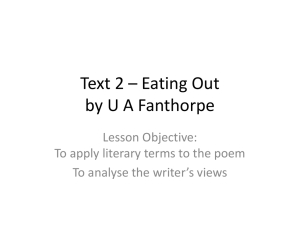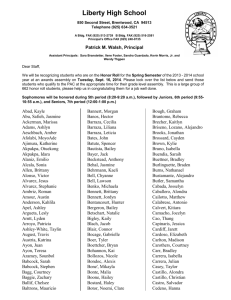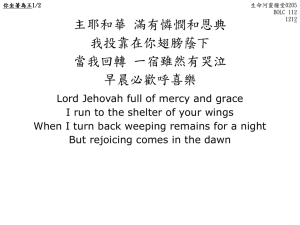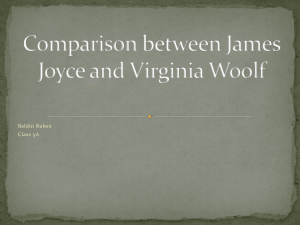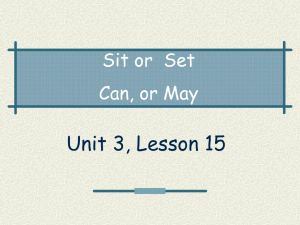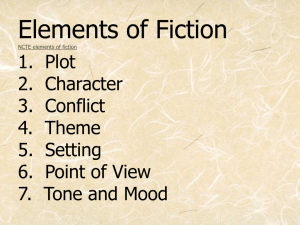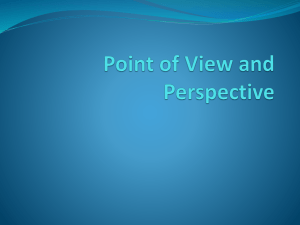Example
advertisement
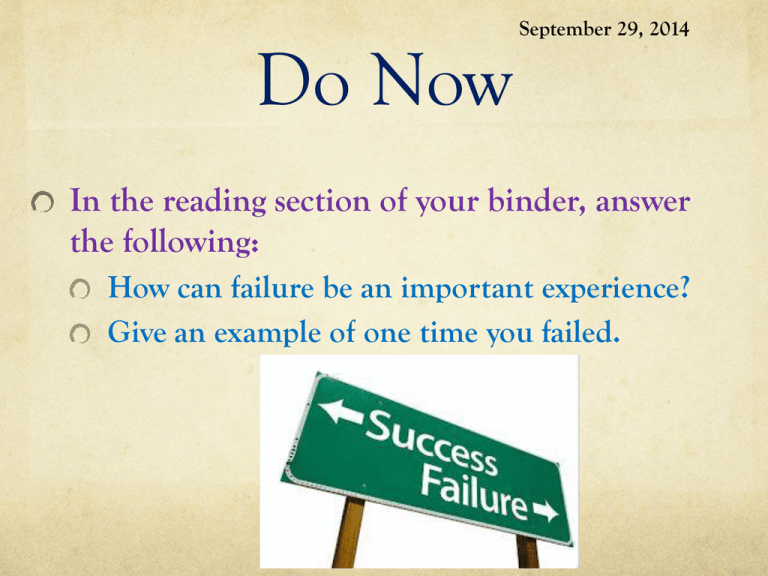
Do Now September 29, 2014 In the reading section of your binder, answer the following: How can failure be an important experience? Give an example of one time you failed. Learning Goal Analyze two texts—an essay and a speech, to form and support a claim about the importance of failure. “After Twenty Years” By: O. Henry September 30 - October 1, 2014 September 30, 2014 Do Now • Pick up a Daily Academic Vocabulary handout from the front of the room. • Complete Days 1 AND 2 on the Daily Academic Vocabulary handout. Learning Goals Using textual evidence to better understand the plot Guess the Celebrity 4 Years old 24 Years old Guess the Celebrity 9 Years old 29 Years old Guess the Celebrity 2 Years old 22 Years old Guess the teacher Vice Principal Sidler Guess the teacher Ms. Heyl Guess the Teacher Mrs. Stoller Guess the teacher Ms. Sarcone Shared Reading of “After Twenty Years” Page 428 Literary Conflict External vs. Internal External Internal External Conflict takes place outside of the body Internal Conflict takes place inside of the body/mind External Conflict There are three types of external conflict Man vs. Man One character vs. another character. Each character wants different things/has different goals, so these two characters are against each other. Man vs. Nature This type of conflict occurs when a story's main character or characters are against a natural force such as a flood, predatory animal, or disease outbreak Man vs. Society In many stories, the protagonist battles an unjust government or culture. Example- The Hunger Games Internal Conflict There is one type of internal conflict Man vs. Self Some literary conflicts take the form of a character struggling to overcome fear, addiction, emotional damage or other crippling personal issue. Point of View First Person Narrator = character in the story Narrator not always reliable We find out only what this character (the narrator) knows, thinks, and witnesses First person pronouns: I, me, my, and mine Example- “I was on my way to the bus stop when I saw Sally inviting Jenny to her birthday party. I wonder if she will invite me to her party…” Second Person Narrator = someone addressing you, the reader Second person pronouns: you, your, and yours are used. Most stories are NOT told in second person. Reserved for items of personal address, such as letters Ex- “Grandma, before you go on your trip, please leave me your keys so I can feed your cat while you’re away. This POV is RARELY used Third Person Limited Narrator = not character in story tells story from one character’s point of view. Narrator can see into the mind of one character. We find out only what this character does, knows, thinks and witnesses. Third person pronouns: he, his, she, hers, it, its, they, and them Example- Harry hoped Voldemort would show up to the party, so he could show him who’s boss. However, he soon realized that Voldemort was not coming. Third Person Omniscient Narrator = not character in the story Third person pronouns: he, his, she, hers, it, its, they, and them Narrator = all-knowing Can see into the minds of all characters Can report what is said and done We find out what all of the characters do, feel, think, and witness Example- “Leslie felt nervous while taking the math test. Then again, her best friend Molly felt nervous too.” Period 1 FIND YOUR NAME AND SIT AT THE LISTED TABLE TABLE 1 • Ryann W. • Kaylee • Neera • Kirsten • Timmy L. TABLE 2 • Zoe • Zainab • John H. • Priyansi • Antonio • Natalie TABLE 3 • Sean W. • Anabella • Emma • Cassidy • Marissa TABLE 4 • Nikhil • Taylor • Ryan H. • Luv • Victoria • Jenna TABLE 5 • Sean P. • Olivia • Adrianna • Isabella • Tim D. • Nina Period 2 FIND YOUR NAME AND SIT AT THE LISTED TABLE TABLE 1 • Connor • Shriya • Ross • Amelia • Ashir • Jocelyn TABLE 2 • Dominick • Nidhi • John • Emma • Julia • Prudvi TABLE 3 • Christiano • Krithika • Anjali • Jacob • Ava • Phil TABLE 4 • Mass • Paul • Kyle • Alexis • Cristen • Richard TABLE 5 • Brendan • Sam • Andrew • Gavin • Matt Period 5 FIND YOUR NAME AND SIT AT THE LISTED TABLE TABLE 1 • Bryant • Izabella • Ajaypal • Sriram • Rohan • Ethan TABLE 2 • Gyan • Dan • Kendra • Paige • Kevin • Julia • Sukhdeep TABLE 3 • Rachel • Wave • David • Megan • Srihaan • Logan • Anish TABLE 4 • Zain • BrookLynn • Jack • Kyle • Kaitlyn • Gianna • Kajal TABLE 5 • Bianca • Nick • Harshi • Jilian • Emily Period 6 FIND YOUR NAME AND SIT AT THE LISTED TABLE TABLE 1 • Jack • Vanessa • Jake • Skyler • Zane TABLE 2 • Akshat • Alyssa • Elyssa • Alexis • Courtney TABLE 3 • Mary • Alex • Rohin • Shivani TABLE 4 • Tolu • Lauren • Lexi • Courtney • Greg TABLE 5 • Lucas • Tisa • Kaitlyn • Matt • James October 1, 2014 Do Now Go back to your graphic organizer from yesterday, and find clues the author gave you that hinted at how “After Twenty Years” would end. Learning Goal Identify plot elements in the story and label them as the exposition/introduction, rising action, climax, and resolution/conclusion. Plot Elements Song http://www.flocabulary.com/plot-elements/ October 2, 2014 Do Now Turn to page 4 in the Scholastic magazines and look at the photos, captions and subheadings in “Lexi Youngberg, Invincible”. Then, examine the articles on pages 9 and 10. By only reading the text features of these three texts, infer the main idea they have in common. Write your inference in the reading section of your binder. Learning Goal Synthesize key ideas from three texts, drawing conclusions about the evolution of prosthetic medicine and how amputees demonstrate resilience. Take a Cornell Notes handout. Complete the Daily Academic Vocabulary days 3 AND 4 Literary Conflict External vs. Internal External Internal External Conflict takes place outside of the body Internal Conflict takes place inside of the body/mind External Conflict There are three types of external conflict Man vs. Man One character vs. another character. Each character wants different things/has different goals, so these two characters are against each other. Man vs. Nature This type of conflict occurs when a story's main character or characters are against a natural force such as a flood, predatory animal, or disease outbreak Man vs. Society In many stories, the protagonist battles an unjust government or culture. Example- The Hunger Games Internal Conflict There is one type of internal conflict Man vs. Self Some literary conflicts take the form of a character struggling to overcome fear, addiction, emotional damage or other crippling personal issue. A figure of speech in which words are used in such a way that their intended meaning is different from the actual meaning of the words. It may also be a situation that may end up in quite a different way than what is generally anticipated. In simple words, it is a difference between the appearance and the reality. An occasion in which the outcome is significantly different from what was expected or considered appropriate. Examples: A man takes a step aside in order to avoid getting sprinkled by a wet dog and falls into a swimming pool. A can of Rust—Oleum that is supposed to prevent things from rusting, but the can itself rusts! A technique that increases suspense by letting readers know more about the dramatic situation than the characters know. Example: Scary Movies- characters have no idea when the murderer is behind them watching their every move, but we as the viewers know she is about to be killed A figure of speech in which what is said is the opposite of what is meant . [a form of sarcasm] Examples: Someone steps into a puddle of water by mistake and a friend remarks “Well now, don’t you have all the luck.” You just received a speeding ticket, and you tell the police officer in your kindest voice, “Thank you so much officer.” “When the policeman on his beat sees a man standing in a doorway, he approaches, and the man explains that he is waiting for an old friend, whom he has not seen in twenty years. The policeman notices the man’s diamonds and remarks, “Did pretty well out West, did you,” and the stranger replies, “You bet!” While the policeman is apparently admiring the mans diamonds, he actually is noting the identity of this stranger. Then he tells the man in the doorway. “I hope your friend comes around all right.” (After Twenty Years) Verbal Irony Because since the policeman is actually the “friend”, he means other than what he says. When the tall man in an overcoat runs up to ‘Silky’ Bob to meet him, Bob believes it is Jimmy Wells. However, when the two men pass under the bright light of a street corner, Bob realizes that the man is not Jimmy Wells. Then, the tall man in an overcoat arrests ‘Silky’ Bob. Situational Irony As readers, we did not expect the tall man in an overcoat to be an undercover policeman who was sent by the real Jimmy Wells to arrest Bob. • The use of hints or clues to suggest what will happen later in literature • Example- Change in setting • “There was now a fine, cold drizzle falling, and the wind had risen from its uncertain puffs into a steady blow. The few foot passengers astir in that quarter hurried dismally and silently along with coat collars turned high and pocketed hands” (After Twenty Years). Action that interrupts to show an event that happened at an earlier time. Necessary for better understanding of the story Example- The Hunger Games- Peeta’s flashback of when he first sees Katniss as a child. • https://www.youtube.com/watch?v=uSibTNevXuk Please take a quiz sheet from the front. Clear your desks and take out a pen. Academic Vocabulary Quiz Time! Short Story unit test review Monday, October 6, 2104 PERIOD 1 FIND YOUR NAME AND SIT AT THE LISTED TABLE TABLE 1 TABLE 2 TABLE 3 TABLE 4 TABLE 5 1. 2. 3. 4. 5. 1. 2. 3. 4. 5. 6. 1. 2. 3. 4. 5. 1. 2. 3. 4. 5. 6. Ryann W. Kaylee Neera Kirsten Timmy L. Zoe Zainab John H. Priyansi Antonio Natalie Sean W. Anabella Emma Cassidy Marissa Expert Groups Nikhil Taylor Ryan H. Luv Victoria Jenna 1. 2. 3. 4. 5. 6. Sean P. Olivia Adrianna Isabella Tim D. Nina Monday, October 6, 2014 Do Now Open to the reading section in your binders. Take a pen out. Put everything else into your backpack. Put your backpack under your desks. Learning Goal Identify literary elements such as characterization, conflict, theme/moral, and figurative language in short stories. PERIOD 1 FIND YOUR NAME AND SIT AT THE LISTED TABLE TABLE 1 1. 2. 3. 4. 5. TABLE 2 Ryann W. 1. Kaylee Zoe 2. Zainab Sean W. 3. Natalie Nikhil 4. Anabella Sean P. 5. Taylor 6. Olivia TABLE 3 1. Neera 2. John H. 3. Emma 4. Ryan H. 5. Adrianna 6. Nina TABLE 4 1. Kirsten 2. Priyansi 3. Cassidy 4. Luv 5. Isabella Teaching Groups TABLE 5 1. Timmy L. 2. Antonio 3. Marissa 4. Victoria 5. Jenna 6. Tim D. Period 2 FIND YOUR NAME AND SIT AT THE LISTED TABLE TABLE 1 1. Connor 2. Shriya 3. Ross 4. Amelia 5. Ashir 6. Krithika TABLE 2 1. Brendan 2. Nidhi 3. John 4. Emma 5. Julia 6. Prudvi TABLE 3 1. Christiano 2. Francesca 3. Anjali 4. Jacob 5. Ava 6. Phil Expert Groups TABLE 4 1. Mass 2. Paul 3. Kyle 4. Alexis 5. Cristen 6. Richard TABLE 5 1. Dominick 2. Sam 3. Andrew 4. Gavin 5. Matt 6. Jocelyn Period 2 FIND YOUR NAME AND SIT AT THE LISTED TABLE TABLE 1 1. Ross 2. Brendan 3. John 4. Francesca 5. Alexis 6. Sam TABLE 2 1. Shriya 2. Prudvi 3. Jacob 4. Cristen 5. Richard 6. Jocelyn TABLE 3 1. Connor 2. Nidhi 3. Ava 4. Paul 5. Andrew TABLE 4 1. Amelia 2. Emma 3. Christiano 4. Kyle 5. Gavin 6. Dominick Teaching Groups TABLE 5 1. Ashir 2. Julia 3. Anjali 4. Phil 5. Mass 6. Matt Period 5 FIND YOUR NAME AND SIT AT THE LISTED TABLE TABLE 1 1. Bryant 2. Izabella 3. Ajaypal 4. Sriram 5. Rohan 6. Ethan TABLE 2 1. Gyan 2. Dan 3. Kendra 4. Paige 5. Kevin 6. Julia TABLE 3 1. Rachel 2. Wave 3. David 4. Megan 5. Srihaan 6. Logan 7. Sukhdeep TABLE 4 1. Zain 2. BrookeLynn 3. Jack 4. Kyle 5. Bianca 6. Gianna Expert Groups TABLE 5 1. Kaitlyn 2. Nick 3. Harshi 4. Jilian 5. Emily 6. Anish Period 5 FIND YOUR NAME AND SIT AT THE LISTED TABLE TABLE 1 1. Ethan 2. Kevin 3. Rachel 4. Srihaan 5. Zain 6. Harshi TABLE 2 1. Izabella 2. Gyan 3. David 4. Sukhdeep 5. BrookeLynn 6. Emily TABLE 3 1. Ajaypal 2. Dan 3. Julia 4. Wave 5. Jack 6. Nick 7. Kaitlyn Teaching Groups TABLE 4 1. Sriram 2. Bryant 3. Kendra 4. Megan 5. Kyle 6. Jilian TABLE 5 1. Rohan 2. Paige 3. Logan 4. Bianca 5. Gianna 6. Anish Period 6 FIND YOUR NAME AND SIT AT THE LISTED TABLE TABLE 1 1. Jack 2. Shivani 3. Jake 4. Alyssa 5. Lexi TABLE 2 1. Akshat 2. Skyler 3. Elyssa 4. Matt 5. Courtney TABLE 3 1. Mary 2. Alex 3. Rohin 4. Vanessa Expert Groups TABLE 4 1. Tolu 2. Lauren 3. Zane 4. Greg TABLE 5 1. Lucas 2. Tisa 3. Kaitlyn 4. Alexis 5. James Period 6 FIND YOUR NAME AND SIT AT THE LISTED TABLE TABLE 1 1. Jack 2. Courtney 3. Rohin 4. Lauren 5. Alexis TABLE 2 1. Shivani 2. Skyler 3. Alex 4. Lucas TABLE 3 1. Jake 2. Elyssa 3. Vanessa 4. Zane 5. Kaitlyn Teaching Groups TABLE 4 1. Alyssa 2. Akshat 3. Greg 4. Tisa TABLE 5 1. Lexi 2. Matt 3. Mary 4. Tolu 5. James REMINDER A blank graphic organizer like the one you did today in class can be found on Mrs. Stoller’s webpage to help you review for the assessment tomorrow. ALL Power Point Presentations and PREZIs that we have done in class can also be found on my webpage. Closure Write any questions you may have on a post-it note that you still need answered prior to the short story assessment tomorrow. Place it on the parking lot on your way out the door. Tuesday, October 7, 2014 SHORT STORY UNIT TEST Put everything away, and take out a pencil. SHORT STORY UNIT TEST Take out a pencil and clear your desk. Take a stapled packet from your desk. Do NOT write on these Take a Scantron from the “Do Now” table. Fill-in the complete heading. Name, Date, Period, ELA, Short Story Test



